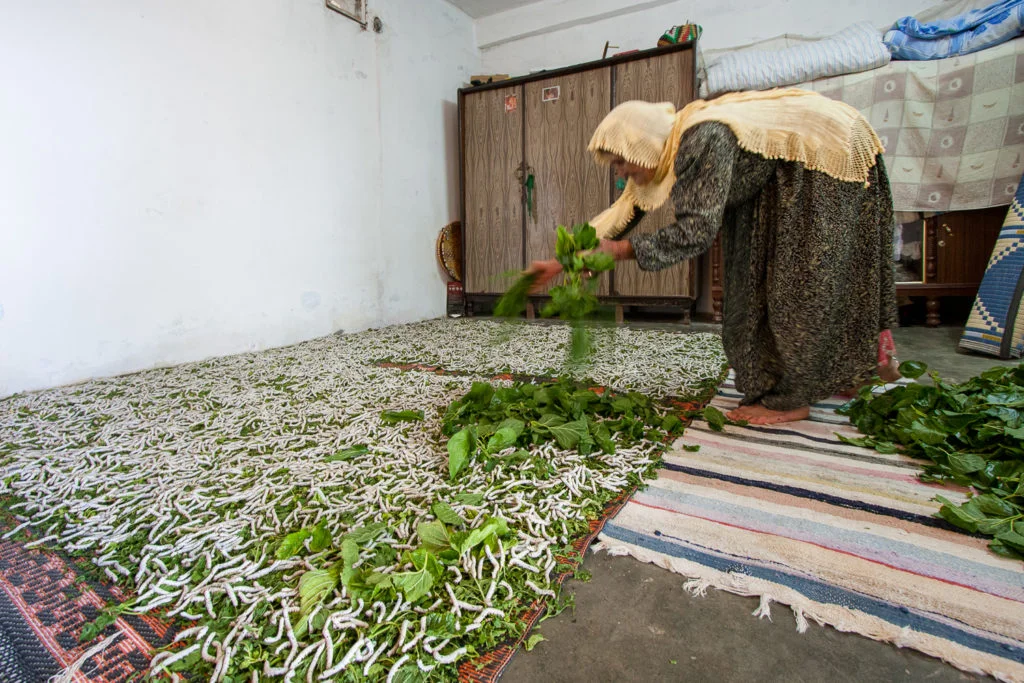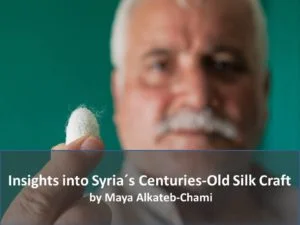by Maya Alkateb-Chami
When I met Um Muhammad (Shahira Hdiyeh) for the first time, she was proudly wearing a hand-made silk shawl [masloubeh مسلوبة] on her head, something she did on many occasions. A mother of three daughters and three sons, five of whom had moved away to urban areas, she lived in the mountainous village of Deir Mama, where she shared a house of two big rooms with her husband, Abu Muhammad (Badie’ Saniyeh). Um Muhammad had reared cocoons with her family since she was a child, then at her marital home for 45 years by the time we met. In 2009, the family earned half of their income through farming (including the cultivation of cocoons), with the other half being contributed by the couple’s children. Um Muhammad processed silk thread (‘throwing’, or twisting and combining), and crocheted silk garments for extra money.

Um Muhammad was very proud of her silk work and refused to quit rearing silkworms despite the urging of some of her children, who said that she had become old for such tiring work. She had crocheted her own shawl years ago and explained to me that it had gotten thin in some areas because it had been applied to the skins of her many grandchildren whenever they got rashes as babies. She believed, based on experience, in its curative qualities. She and her husband reared silkworms every spring, using the frequent help of their daughter who lived close-by.
The rearing took place at their home, where they emptied the two big rooms for the worms for about twenty days per year and slept outside. The couple laboriously picked mulberry leaves off of their own trees and carried them to the house on foot, then collaborated to collect dry branches and arrange them to form ‘mountages’ that the worms would eventually climb to spin cocoons.
The silkworm (Bombyx mori) that is reared in Syria is fully dependent on humans: leaves have to be finely chopped for the worms when they are little and have to be served to them. Certain ranges of heat and humidity should be maintained in the rearing environment, which also has to be free of smoke, odors, and even disturbing noise. Leaves that may have been exposed to pesticides from other crops cannot be used, and natural predators, such as ants and mice, must be kept away. In general, the more care the worms get, the bigger and nicer cocoons they make—and the higher the value of the crop.


The domesticated silkworm reared in Syria is fully dependent upon humans and cannot survive in the wild. For about 20 days per year, the hungry crop takes over its rearers’ houses in addition to consuming their labor. (© Hany Hawasly)
A silkworm takes about 35 days between hatching from its egg and starting to wrap itself in a cocoon. During that time, it passes through five different ages (each lasting about a week) and increases about 10,000 times in weight. In the village of Deir Mama, the first four ages draw their local names from the physical characteristics of the silkworms: The first is called ‘the seed’ [al-bizreh البزرة], the second ‘the green’ [al-khadra الخضرة], the third ‘the pattern’ [al-naqsheh النقشة], and the fourth ‘the red’ [al-hamra الحمرا]. The fifth age has no specific name, but gets referred to with phrases such as ‘after the sleep of al-hamra [ba’ed nomet al-hamra بعد نومة الحمرا ]‘, ‘we’ve broken their (the silkworms’) fasting for (x) number of days [ilna mfattrin (x) days إلنا مفطرين (س) يوم]‘ and the like.
Each silkworm age ends with a fasting period and a casting of a worm’s skin. When I met them, Um and Abu Muhammad had always obtained the eggs [seeds/ bizir بزر] through the Syrian Ministry of Agriculture and normally sold their cocoon yield to a neighbor, whose family reeled silk manually. In 2009, they reared one carton of ‘seeds’, weighing almost 12 grams and containing 22 thousand silkworm eggs in the two big rooms of their house. When the worms grew big, they placed them on mattresses on the floor, on furniture and Styrofoam boxes, and on plates made of mixed cow dung, straw, and water, then dried in the sun [kreinat كرينات].


A silkworm takes about 35 days between hatching from its egg and starting to wrap itself in a cocoon, where the caterpillar will metamorphose into an adult silk moth. (© Hany Hawasly)
Um Muhammad handled the delicate worms as if they were her pets, watching that they had enough food, and generating heat or opening up the windows for them as needed. During their last ages, one carton consumed about four big bags of mulberry foliage per day, split over three meals. Those are equivalent to the yield of one to four healthy elderly white mulberry trees (Morus alba) of the native variety [tut baladi توت بلدي].
When the big silkworms started turning transparent, Um Muhammad and her husband rushed to bring the natural ‘mountages’ that they had assembled earlier of dry branches of shrubs [shieh شيح], in order to accommodate the worms that were now ready to start spinning cocoons. In one week, the yield was collected and sold before the metamorphosis ended and the moths emerged from their shelters as adults, eating their way out. A month after, in August, the family signed up to get new silkworm eggs the following spring.
By Maya Alkateb-Chami, based on her research for Syrian Silk: Portrait of a Living Cultural Heritage
Read our interview with Maya Alkateb-Chami on silk making in Syria:

